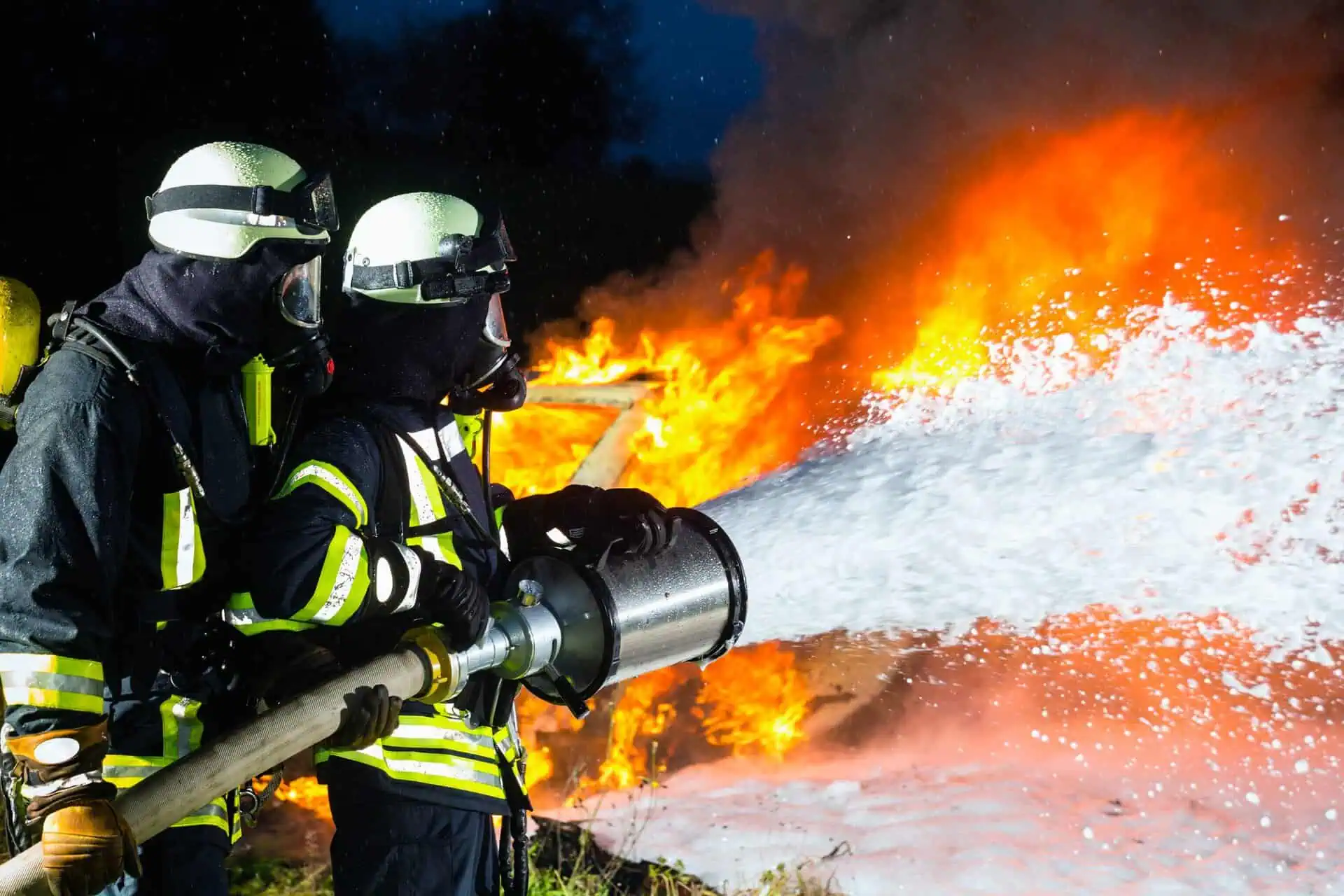FAQ: Has the AFFF Lawsuit Been Settled?
- Last Updated: June 12th, 2025

Attorney Jessica Paluch-Hoerman, founder of TruLaw, has over 28 years of experience as a personal injury and mass tort attorney, and previously worked as an international tax attorney at Deloitte. Jessie collaborates with attorneys nationwide — enabling her to share reliable, up-to-date legal information with our readers.
Legally Reviewed
This article has been written and reviewed for legal accuracy and clarity by the team of writers and legal experts at TruLaw and is as accurate as possible. This content should not be taken as legal advice from an attorney. If you would like to learn more about our owner and experienced injury lawyer, Jessie Paluch, you can do so here.
Fact-Checked
TruLaw does everything possible to make sure the information in this article is up to date and accurate. If you need specific legal advice about your case, contact us by using the chat on the bottom of this page. This article should not be taken as advice from an attorney.
Key takeaways:
- These lawsuits claim that these companies knowingly exposed consumers to harmful substances without adequate warnings.
- In several firefighting foam lawsuit settlements, manufacturers had to pay hefty fines for contaminating local environments.
- Significance of this understanding extends beyond individual personal injury claims and into the realm of class action lawsuits, where a single decision can impact many.
Has the AFFF Lawsuit Been Settled?
Question: Has the AFFF Lawsuit been settled?
Answer: No, currently the AFFF Lawsuit has not reached a full settlement.
Legal proceedings are ongoing — while no full settlement has been reached yet, the landscape can change quickly, so it’s important to stay informed about the latest updates.
You can do so by routinely checking our main AFFF lawsuit page, which we update regularly as new developments occur in the AFFF firefighting foam — you can find our main AFFF lawsuit page here.
On this page, we’ll discuss this question in further depth, potential AFFF lawsuit settlement amounts, who qualifies to file an AFFF lawsuit, and much more.
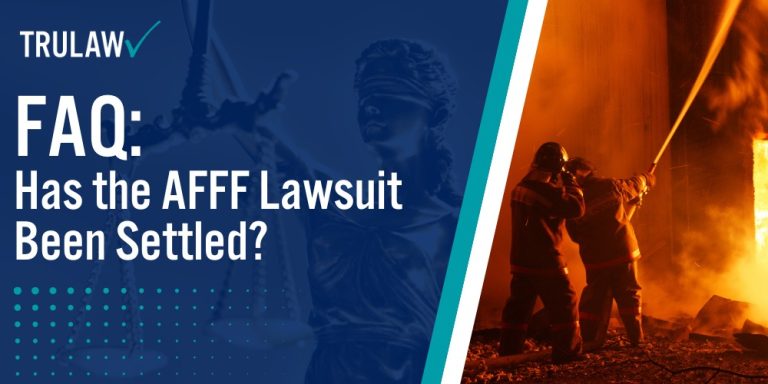
What is the Projected Average Settlement Amount for Firefighting Foam Cancer Cases?
If you or someone you know has been diagnosed with cancer after exposure to firefighting foam, you may be entitled to compensation.
Firefighting foam, or Aqueous Film-Forming Foam (AFFF), contains harmful PFAS chemicals that experts have linked to cancer.
While no settlements have been reached yet in the AFFF litigation, estimates suggest that AFFF lawsuit settlement amounts could range between $20,000 and $600,000 (or more), depending on the details of the case and individual factors.
It’s important to note that these settlement figures are not guarantees, but rather projections based on the outcomes of other mass tort cases involving cancer diagnoses.
If you or a loved one were exposed to AFFF and later developed cancer or related health conditions, you may qualify to pursue an AFFF lawsuit.
You can use the chatbot on this page to instantly determine if you may be eligible to file an AFFF lawsuit.
TruLaw is here to assist those affected by firefighting foam exposure — reach out today to find out more about your potential AFFF claim.
Table of Contents
What is the AFFF Firefighting Foam Lawsuit?
Aqueous Film-Forming Foam (AFFF) is a firefighting foam that has been used since the 1960s, initially developed by 3M and adopted by the U.S. military.
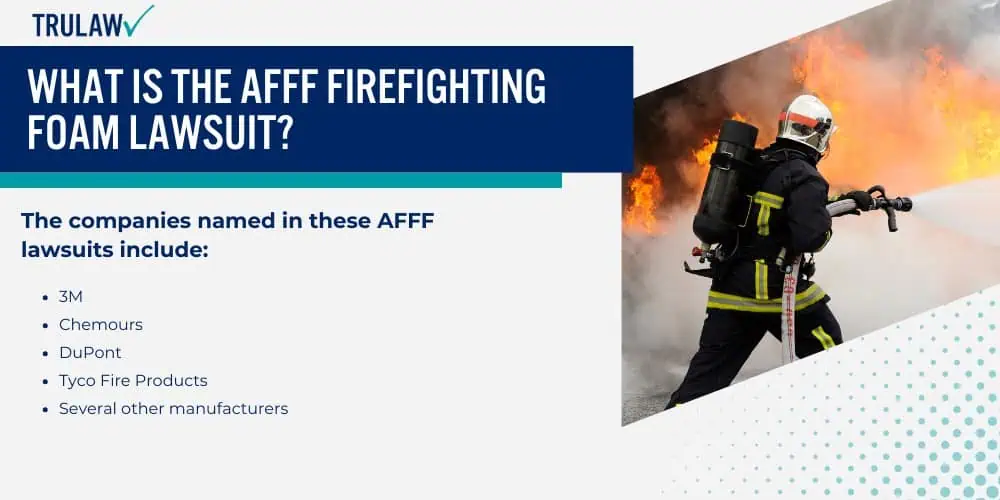
AFFF is specifically designed to extinguish highly flammable liquid fires fueled by substances like gasoline, oil, and jet fuel.
Some formulations of AFFF are made with fluorosurfactants, which belong to a group of chemicals known as PFAS, or “forever chemicals.”
These substances persist in both the environment and the human body, raising concerns about long-term contamination.
AFFF Firefighting Foam Lawsuits have been filed by individuals who were exposed to AFFF and later developed cancer or other serious health conditions.
Across the country, firefighters from public services, airports, and the military are pursuing legal action against multiple companies responsible for producing AFFF.
The companies named in these AFFF lawsuits include:
- 3M
- Chemours
- DuPont
- Tyco Fire Products
- Several other manufacturers
TruLaw works with litigation leaders to asses AFFF injury claims from individuals affected by toxic firefighting foam.
If you believe you may qualify for an AFFF lawsuit, you can reach out to us today by using the chatbot on this page to quickly determine your eligibility to join others filing in the AFFF MDL today.
AFFF Firefighting Foam Lawsuits: Diagnoses & Health Conditions Linked to AFFF Exposure
Over the years, exposure to Aqueous Film-Forming Foam (AFFF) has impacted both firefighters and members of the public.
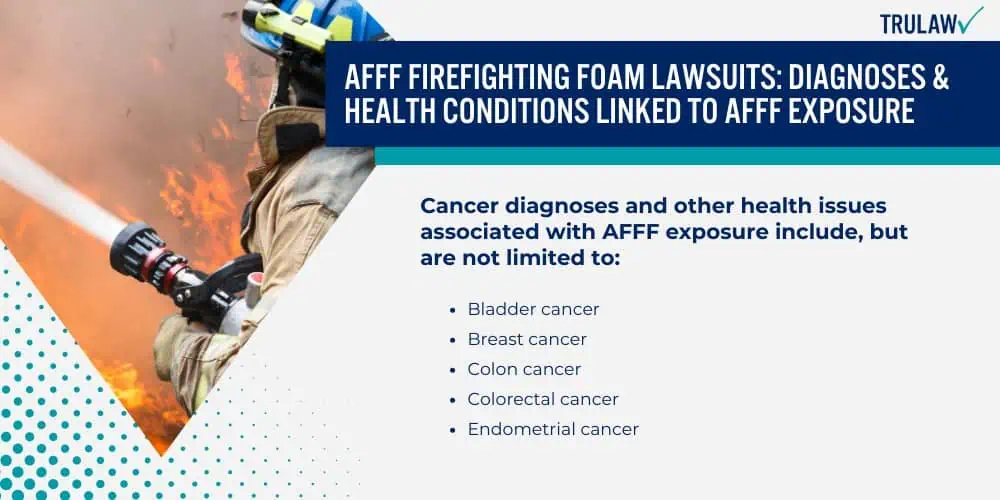
The health conditions linked to this exposure are often severe and have long-term effects on both physical and mental well-being.
Firefighters who have directly handled AFFF and individuals from communities affected by contamination have been pursuing legal action against foam manufacturers for a range of related health issues.
The consequences of this exposure are serious and, in many cases, life-threatening.
Cancer diagnoses and other health issues associated with AFFF exposure include, but are not limited to:
- Bladder cancer
- Breast cancer
- Colon cancer
- Colorectal cancer
- Endometrial cancer
- Kidney cancer
- Leukemia
- Liver cancer
- Lymphoma
- Mesothelioma
- Multiple Myeloma
- Non-Hodgkin Lymphoma
- Ovarian cancer
- Pancreatic cancer
- Prostate cancer
- Rectal cancer
- Testicular cancer
- Thyroid cancer
- Thyroid disease
- Ulcerative Colitis
- Birth defects and other reproductive issues
- Developmental problems
- Heart disease
- Hormonal imbalances
- Immune system disorders
- Liver damage
- Neuroendocrine tumors
- Reproductive issues
- Skin and eye irritation
- Other health complications
In addition to the increased risk of cancer and various diseases from PFAS exposure, individuals exposed to AFFF may also face a heightened risk of developing cardiovascular disease and diabetes.
These health impacts highlight the ongoing concerns about the dangers of firefighting foam and its long-term effects on those exposed.
How Much Can You Expect from AFFF Lawsuit Settlements?
Because firefighting foam cancer lawsuits are still in the early stages, it’s challenging to predict potential compensation amounts with certainty.
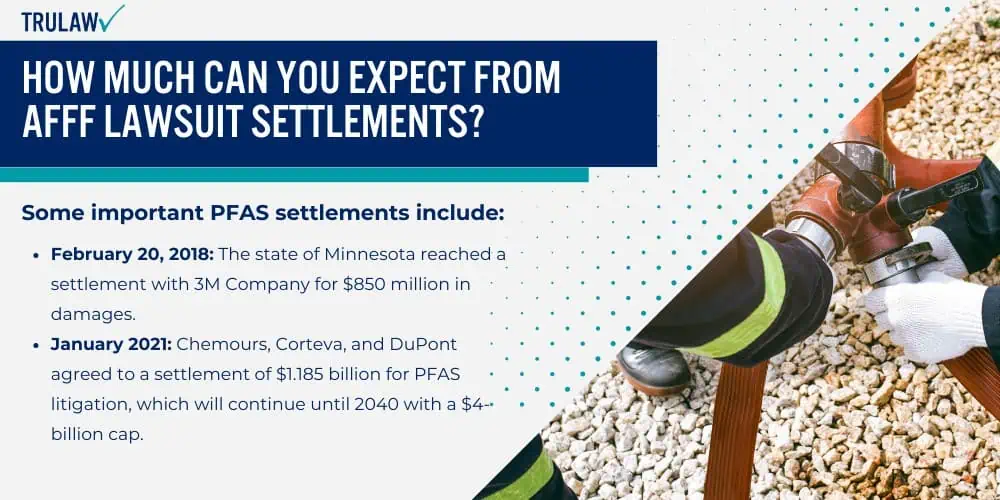
Firefighting foam cancer lawyers estimate that individual AFFF lawsuit settlement amounts may range between $20,000 and $600,000 (or more), depending on the specific details and strength of each case.
No settlements have been reached for firefighting foam cancer lawsuits at this time.
These figures are only projections based on settlements from other mass tort cases involving cancer diagnoses.
There is no guarantee of financial compensation in the AFFF lawsuit.
If you’re seeking detailed insight into what to expect from an AFFF lawsuit, it’s best to consult with legal professionals experienced in AFFF firefighting foam cases.
Examples of Previous PFAS Settlement Amounts
While no AFFF settlements have been reached yet, there have been several notable settlements in PFAS-related litigation, primarily involving contamination from these toxic chemicals.
Some important PFAS settlements include:
- February 20, 2018: The state of Minnesota reached a settlement with 3M Company for $850 million in damages. The lawsuit, filed in 2010, claimed that 3M’s PFAS production contaminated drinking water and natural resources in the Twin Cities area.
- January 2021: Chemours, Corteva, and DuPont agreed to a settlement of $1.185 billion for PFAS litigation, which will continue until 2040 with a $4-billion cap. The lawsuit involved claims that toxic AFFF firefighting foams contaminated drinking water.
- January 2021: Residents of Peshtigo, Wisconsin, reached a $17.5 million settlement with Tyco Fire Products and two other companies for PFAS contamination resulting from the use of AFFF in the area.
- July 2021: Chemours, Corteva, and DuPont also reached a $50 million settlement in Delaware for PFAS-related contamination claims.
Factors Influencing AFFF Exposure Lawsuit Settlement Amounts
Several factors can influence the potential compensation in an AFFF exposure lawsuit.
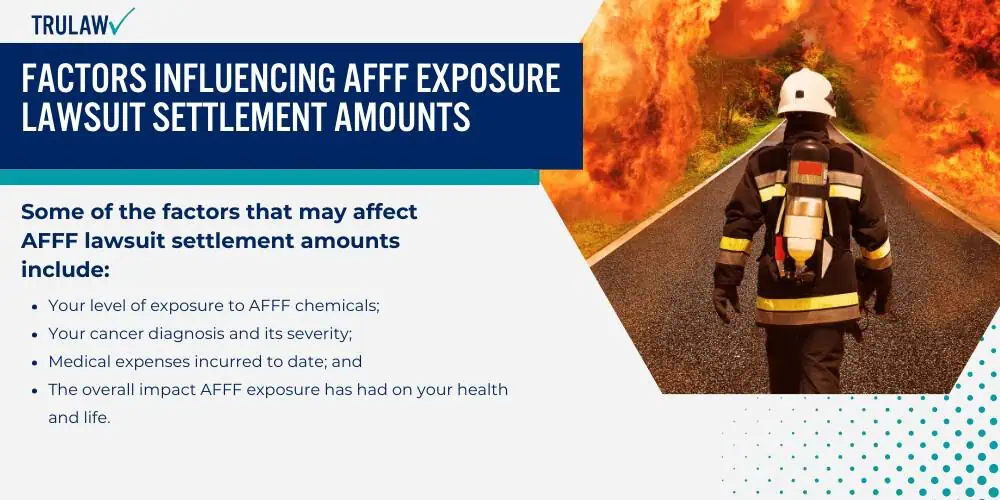
The AFFF firefighting foam lawyers at TruLaw and our partner law firms will work with you to evaluate the specifics of your case by considering key details that could impact the value of your claim.
Some of the factors that may affect AFFF lawsuit settlement amounts include:
- Your level of exposure to AFFF chemicals;
- Your cancer diagnosis and its severity;
- Medical expenses incurred to date; and
- The overall impact AFFF exposure has had on your health and life.
Extent of AFFF/PFAS Exposure
One of the most important factors in determining compensation is the level of exposure to AFFF chemicals.
Individuals, particularly firefighters, may have encountered firefighting foam regularly throughout their careers.
Those stationed at military bases or working in environments like airports may have experienced prolonged exposure, which could strengthen their claims.
Cancer Diagnoses Related to AFFF
Exposure to AFFF and the PFAS chemicals it contains has been linked to various types of cancer.
The amount of compensation available can vary depending on the specific diagnosis and the extent of the harm caused.
Those with more advanced or aggressive forms of cancer may be entitled to larger settlements compared to individuals whose conditions are more easily managed or treated.
Current and Past Medical Expenses
The medical costs already incurred by individuals affected by AFFF exposure are a factor in determining settlement amounts.
Many victims may have already undergone diagnostic tests, treatments, or therapy sessions before learning of the connection between their illness and AFFF exposure.
These expenses are considered when calculating potential compensation.
Projected Future Medical Costs
Ongoing and future medical needs are another consideration in these AFFF cancer lawsuits.
Cancer treatment often involves long-term care, including additional surgeries, therapy, and consultations with specialists.
Future medical costs, including the potential for rehabilitation and psychological support, can be included in settlement calculations to ensure victims are compensated for all anticipated care.
TruLaw can help evaluate the full range of expenses associated with your case, working to ensure that any future medical needs related to cancer treatment are considered when seeking compensation.
Are You Eligible to File an AFFF Lawsuit?
Thousands of individuals across the United States are filing lawsuits after being exposed to AFFF firefighting foam and developing serious health conditions.
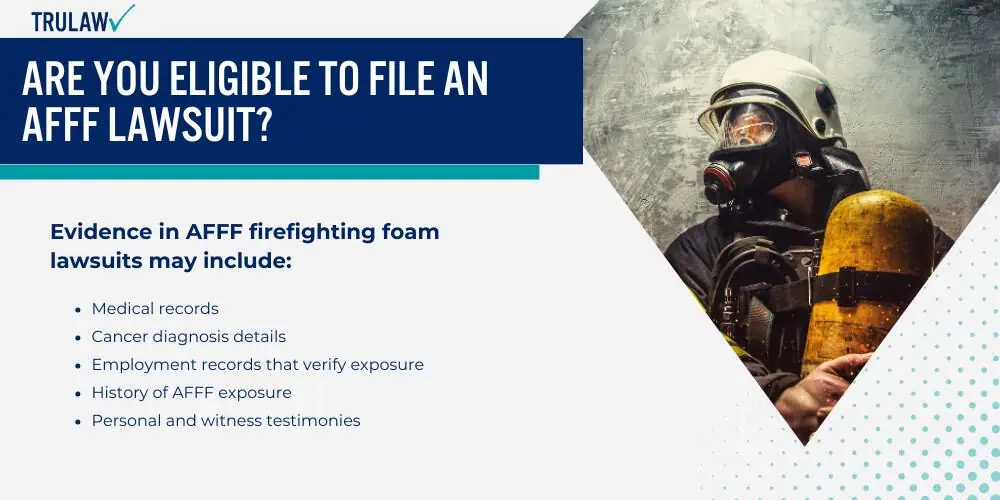
If you or a loved one has been exposed to AFFF and have since developed cancer or other health problems, you may qualify to file an AFFF lawsuit.
Contact TruLaw for more information by using the instant case evaluator chatbot on this page to quickly determine your eligibility for the AFFF lawsuit.
It’s important to be aware that each state has its own statutes of limitations, which set deadlines for filing PFAS chemical exposure lawsuits.
Our team can help identify these important deadlines and ensure your case is filed on time.
We also support clients by assisting with the steps involved in filing an AFFF lawsuit, such as gathering evidence and assessing damages.
Collecting Evidence for Firefighting Foam Lawsuits
Evidence plays a large role in AFFF lawsuits, particularly when dealing with toxic chemical exposure.
Having the right documentation and testimony can strengthen your claim.
Evidence in AFFF firefighting foam lawsuits may include:
- Medical records
- Cancer diagnosis details
- Employment records that verify exposure
- History of AFFF exposure
- Personal and witness testimonies
- Any other information that supports your exposure to AFFF
Evaluating Damages in an AFFF Firefighting Foam Lawsuit
Damages are the losses, both economic and non-economic, that you’ve incurred as a result of your AFFF exposure.
These will be evaluated to determine the compensation you may seek.
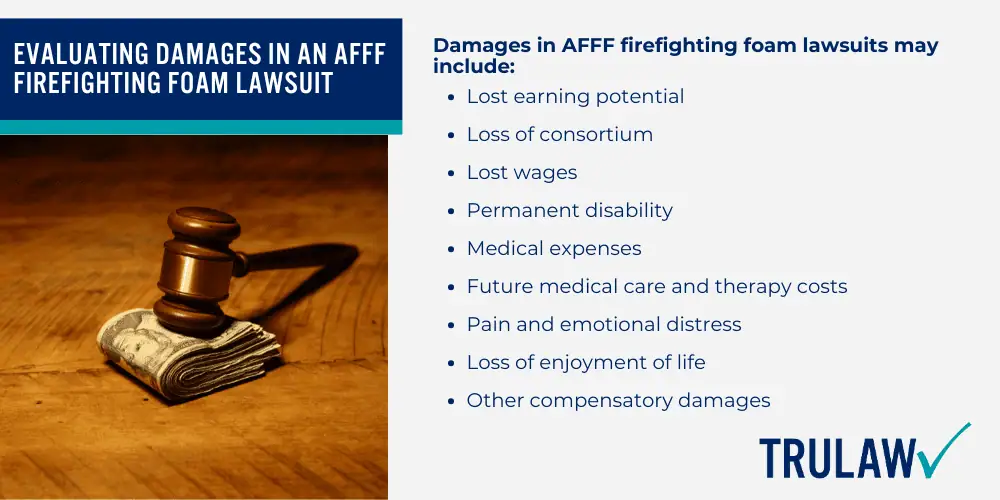
Damages in AFFF firefighting foam lawsuits may include:
- Medical expenses
- Lost wages
- Pain and suffering, emotional distress
- Loss of earning capacity
- Loss of enjoyment of life
- Permanent disability
- Future medical expenses and therapy costs
- Other compensatory and punitive damages
- Loss of consortium
The firefighting foam lawyers at TruLaw and our partner law firms are prepared to help you through the process of gathering evidence and evaluating damages — giving you the guidance and support needed during this challenging time.
TruLaw: Your Firefighting Foam Cancer Law Firm
TruLaw is currently accepting clients for AFFF lawsuits across all 50 states.
Our team brings years of litigation experience to the table, helping clients seek fair compensation for the harm they’ve suffered due to the negligence of others.
We understand the challenges that come with serious health conditions and the impact they have on you and your family.
Our goal is to ensure that you have the legal support you need while you focus on your recovery.
If you or a loved one were exposed to AFFF firefighting foam and later developed cancer or other related health problems, you may be eligible to join others who are pursuing lawsuits for AFFF exposure.
Contact TruLaw for more information by using the instant case evaluator chatbot on this page to quickly determine your eligibility for the AFFF lawsuit.
AFFF Lawsuit Frequently Asked Questions
-
No settlement has been reached in the firefighting foam lawsuits so far.
However, AFFF lawyers estimate that potential AFFF lawsuit settlement amounts may range between $20,000 and $600,000 (or more), depending on the specific circumstances and damages in individual cases.
These figures are not guaranteed — they are merely projections based on past mass tort cases involving similar cancer diagnoses.
If you believe you may qualify for an AFFF lawsuit, you can reach out to us today by using the chatbot on this page to quickly determine your eligibility to join others filing in the AFFF MDL today.
-
Aqueous film forming foam (AFFF) is a specialized firefighting foam used to suppress fires fueled by highly flammable liquids, such as oil, gasoline, and jet fuel.
For decades, AFFF has been widely used by firefighters at airports, military bases, and industrial sites due to its effectiveness in extinguishing class B fires.
Unfortunately, AFFF often contains PFAS chemicals, commonly known as “forever chemicals,” which have been linked to a range of cancers and other serious health conditions.
-
AFFF firefighting foam containing PFAS chemicals is highly toxic and has been associated with various types of cancer.
These cancers include, but are not limited to:
- Bladder cancer
- Breast cancer
- Colon cancer
- Colorectal cancer
- Endometrial cancer
- Kidney cancer
- Leukemia
- Liver cancer
- Lymphoma
- Mesothelioma
- Multiple Myeloma
- Non-Hodgkin Lymphoma
- Ovarian cancer
- Pancreatic cancer
- Prostate cancer
- Rectal cancer
- Testicular cancer
- Thyroid cancer
These cancers highlight the serious health risks associated with exposure to PFAS chemicals in firefighting foam.
-
No, there is no AFFF class action lawsuit for cancer and other health issues related to AFFF exposure.
Instead, AFFF lawsuits have been consolidated into multidistrict litigation (MDL).
The AFFF firefighting foam MDL is a legal process designed to manage a large number of similar lawsuits efficiently by consolidating them in one court for pretrial proceedings.
This process differs from class action lawsuits, where compensation is typically distributed equally among all plaintiffs.
In an MDL, settlements are based on the specific details and damages of each individual case.
The AFFF MDL is currently centralized in the US District Court for the District of South Carolina.
-
Occupational exposure is the most common way people come into contact with AFFF firefighting foam.
Firefighters, particularly those working at airports and military installations, have used AFFF extensively in fire suppression and training exercises.
Other individuals may be exposed through groundwater contamination or incidental contact with AFFF.
Industrial workers and those involved in the transportation or disposal of AFFF are also at risk for health problems related to PFAS exposure.

Managing Attorney & Owner
With over 25 years of legal experience, Jessica Paluch-Hoerman is an Illinois lawyer, a CPA, and a mother of three. She spent the first decade of her career working as an international tax attorney at Deloitte.
In 2009, Jessie co-founded her own law firm with her husband – which has scaled to over 30 employees since its conception.
In 2016, Jessie founded TruLaw, which allows her to collaborate with attorneys and legal experts across the United States on a daily basis. This hypervaluable network of experts is what enables her to share the most reliable, accurate, and up-to-date legal information with our readers!
Additional AFFF Lawsuit resources on our website:
Here, at TruLaw, we’re committed to helping victims get the justice they deserve.
Alongside our partner law firms, we have successfully collected over $3 Billion in verdicts and settlements on behalf of injured individuals.
Would you like our help?
At TruLaw, we fiercely combat corporations that endanger individuals’ well-being. If you’ve suffered injuries and believe these well-funded entities should be held accountable, we’re here for you.
With TruLaw, you gain access to successful and seasoned lawyers who maximize your chances of success. Our lawyers invest in you—they do not receive a dime until your lawsuit reaches a successful resolution!
AFFF Lawsuit claims are being filed against manufacturers of aqueous film-forming foam (AFFF), commonly used in firefighting.
Claims allege that companies such as 3M, DuPont, and Tyco Fire Products failed to adequately warn users about the potential dangers of AFFF exposure — including increased risks of various cancers and diseases.
Depo Provera Lawsuit claims are being filed by individuals who allege they developed meningioma (a type of brain tumor) after receiving Depo-Provera birth control injections.
A 2024 study found that women using Depo-Provera for at least 1 year are five times more likely to develop meningioma brain tumors compared to those not using the drug.
Suboxone Tooth Decay Lawsuit claims are being filed against Indivior, the manufacturer of Suboxone, a medication used to treat opioid addiction.
Claims allege that Indivior failed to adequately warn users about the potential dangers of severe tooth decay and dental injuries associated with Suboxone’s sublingual film version.
Social Media Harm Lawsuits are being filed against social media companies for allegedly causing mental health issues in children and teens.
Claims allege that companies like Meta, Google, ByteDance, and Snap designed addictive platforms that led to anxiety, depression, and other mental health issues without adequately warning users or parents.
Transvaginal Mesh Lawsuits are being filed against manufacturers of transvaginal mesh products used to treat pelvic organ prolapse (POP) and stress urinary incontinence (SUI).
Claims allege that companies like Ethicon, C.R. Bard, and Boston Scientific failed to adequately warn about potential dangers — including erosion, pain, and infection.
Bair Hugger Warming Blanket Lawsuits involve claims against 3M — alleging their surgical warming blankets caused severe infections and complications (particularly in hip and knee replacement surgeries).
Plaintiffs claim 3M failed to warn about potential risks — despite knowing about increased risk of deep joint infections since 2011.
Baby Formula NEC Lawsuit claims are being filed against manufacturers of cow’s milk-based baby formula products.
Claims allege that companies like Abbott Laboratories (Similac) and Mead Johnson & Company (Enfamil) failed to warn about the increased risk of necrotizing enterocolitis (NEC) in premature infants.
Here, at TruLaw, we’re committed to helping victims get the justice they deserve.
Alongside our partner law firms, we have successfully collected over $3 Billion in verdicts and settlements on behalf of injured individuals.
Would you like our help?
